MAZDA MODEL CX-5 2018 (in English) Repair Manual
Manufacturer: MAZDA, Model Year: 2018, Model line: MODEL CX-5, Model: MAZDA MODEL CX-5 2018Pages: 628, PDF Size: 82.38 MB
Page 61 of 628

Do not attach objects on or around the area where a side air bag deploys:
Attaching objects to the front seat in such a way as to cover the outboard side of the seat in
any way is dangerous. In an accident the object could interfere with the side air bag, which
inflates from the outboard side of the front seat s, impeding the added protection of the side
air bag system or redirecting the air bag in a way that is dangerous. Furthermore, the bag
could be cut open releasing the gas.
Do not hang net bags, map pouches or backpacks with side straps on the front seats. Never
use seat covers on the front seats. Always keep the side air bag modules in your front seats
free to deploy in the event of a side collision.
Do not attach objects on or around the area where a curtain air bag deploys:
Attaching objects to the areas where the curtain air bag activates such as on the windshield
glass, side door glass, front and rear window p illars and along the roof edge and assist grips is
dangerous. In an accident the object could interfere with the curtain air bag, which inflates
from the front and rear window pillars an d along the roof edge, impeding the added
protection of the curtain air bag system or redirecting the air bag in a way that is dangerous.
Furthermore, the bag could be cut open releasing the gas.
Do not place hangers or any other objects on the assist grips. When hanging clothes, hang
them on the coat hook directly. Always keep th e curtain air bag modules free to deploy in the
event of a side collision or roll-over accident.
Do not touch the components of the supplemental restraint system after the air bags have
inflated:
Touching the components of the supplemental restraint system after the air bags have
inflated is dangerous. Immediately after inflation , they are very hot. You could get burned.
Never install any front-end equipment to your vehicle:
Installation of front-end equipment, such as frontal protection bar (kangaroo bar, bull bar,
push bar, or other similar devices), snowplow , or winches, is dangerous. The air bag crash
sensor system could be affected. This could cause air bags to
inflate unexpectedly, or it could
prevent the air bags from infla ting during an accident. Front occupants could be seriously
injured.
Do not modify the suspension:
Modifying the vehicle suspension is dangerous. If the vehicle's height or the suspension is
modified, the vehicle will be unable to accura tely detect a collision or roll-over accident
resulting in incorrect or unexpected air bag depl oyment and the possibility of serious injuries.
Essential Safety Equipment
SRS Air Bags
2-47
CX-5_8GN5-EA-17J_Edition1 2017-8-18 12:58:27
Page 62 of 628
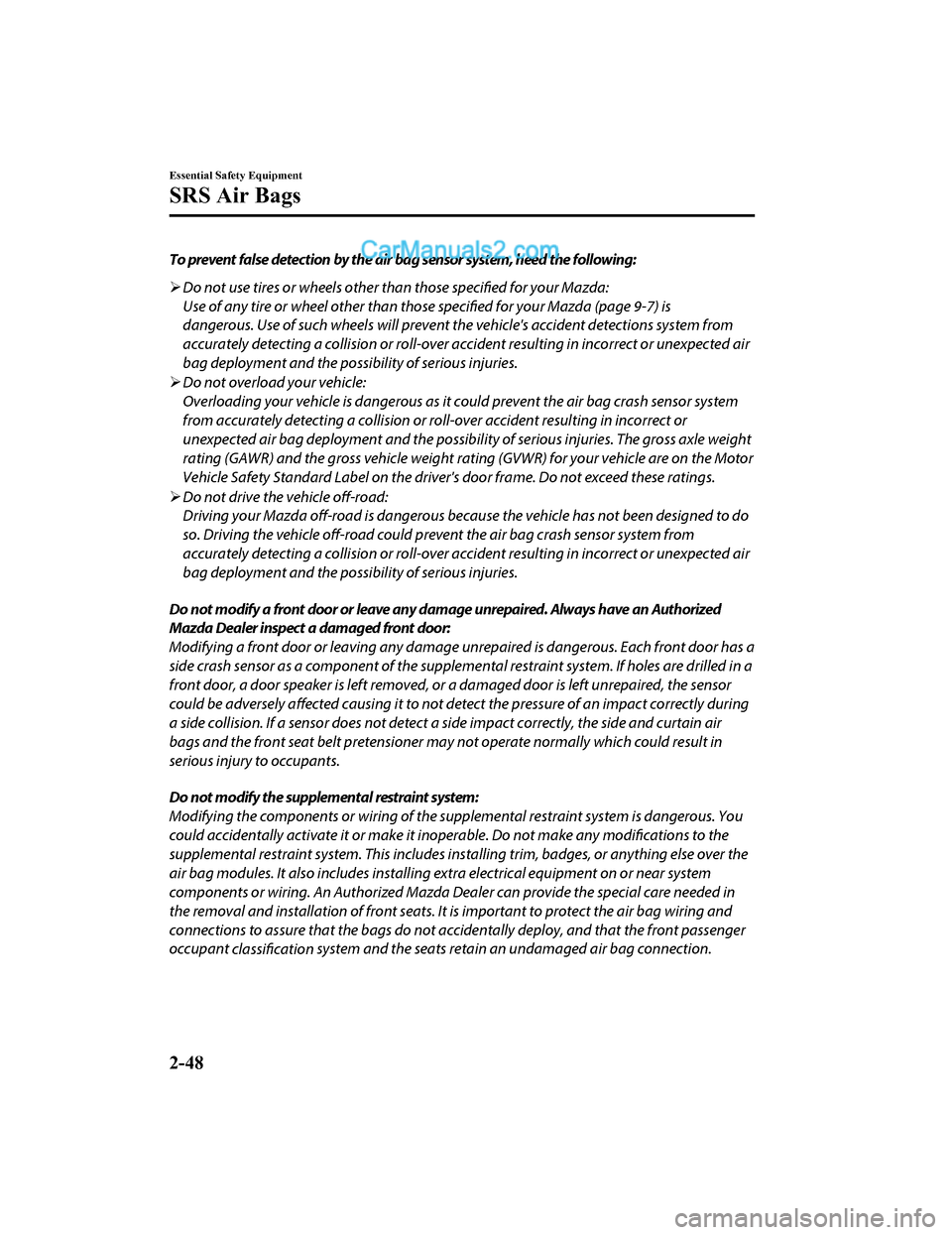
To prevent false detection by the air bag sensor system, heed the following:
Do not use tires or wheels other th an those specified for your Mazda:
Use of any tire or wheel other than thos e specified for your Mazda (page 9-7) is
dangerous. Use of such wheels will prevent th e vehicle's accident detections system from
accurately detecting a collision or roll-over accident resulting in incorrect or unexpected air
bag deployment and the possibility of serious injuries.
Do not overload your vehicle:
Overloading your vehicle is dangerous as it could prevent the air bag crash sensor system
from accurately detecting a collision or roll-over accident resulting in incorrect or
unexpected air bag deployment and the possibili ty of serious injuries. The gross axle weight
rating (GAWR) and the gross vehicle weight rati ng (GVWR) for your vehicle are on the Motor
Vehicle Safety Standard Label on the driver's door frame. Do not exceed these ratings.
Do not drive the vehicle off-road:
Driving your Mazda off-road is dangerous beca use the vehicle has not been designed to do
so. Driving the vehicle off-road could prev ent the air bag crash sensor system from
accurately detecting a collision or roll-over accident resulting in incorrect or unexpected air
bag deployment and the possibility of serious injuries.
Do not modify a front door or leave any da mage unrepaired. Always have an Authorized
Mazda Dealer inspect a damaged front door:
Modifying a front door or leaving any damage unrepaired is dangerous. Each front door has a
side crash sensor as a component of the suppleme ntal restraint system. If holes are drilled in a
front door, a door speaker is left removed, or a damaged door is left unrepaired, the sensor
could be adversely affected causing it to not de tect the pressure of an impact correctly during
a side collision. If a sensor does not detect a side impact correctly, the side and curtain air
bags and the front seat belt pretensioner may not operate normally which could result in
serious injury to occupants.
Do not modify the supplemental restraint system:
Modifying the components or wiring of the su pplemental restraint system is dangerous. You
could accidentally activate it or make it inoperable. Do not make any modifications to the
supplemental restraint system. This includes inst alling trim, badges, or anything else over the
air bag modules. It also includes installing extra electrical equipment on or near system
components or wiring. An Authorized Mazda Dealer can provide the special care needed in
the removal and installation of front seats. It is important to protect the air bag wiring and
connections to assure that the bags do not ac cidentally deploy, and that the front passenger
occupant classification system and the seats retain an undamaged air bag connection.
Essential Safety Equipment
SRS Air Bags
2-48
CX-5_8GN5-EA-17J_Edition1
2017-8-18 12:58:27
Page 63 of 628
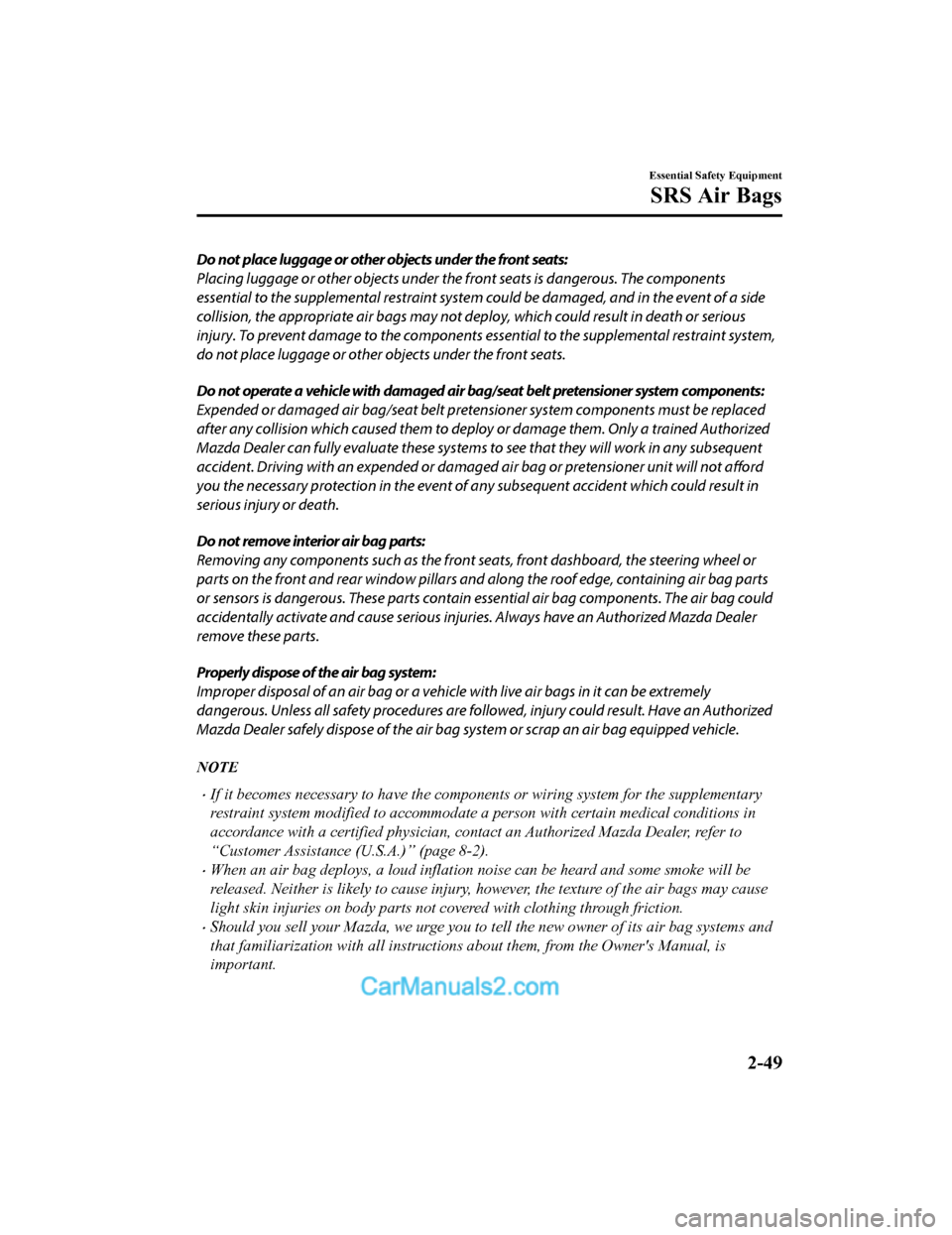
Do not place luggage or other objects under the front seats:
Placing luggage or other objects under the front seats is dangerous. The components
essential to the supplemental restraint system could be damaged, and in the event of a side
collision, the appropriate air bags may not de ploy, which could result in death or serious
injury. To prevent damage to the components essential to the supplemental restraint system,
do not place luggage or other objects under the front seats.
Do not operate a vehicle with damaged air bag/seat belt pretensioner system components:
Expended or damaged air bag/seat belt preten sioner system components must be replaced
after any collision which caused them to deploy or damage them. Only a trained Authorized
Mazda Dealer can fully evaluate these systems to see that they will work in any subsequent
accident. Driving with an expended or dama ged air bag or pretensioner unit will not
afford
you the necessary protection in the event of any subsequent accident which could result in
serious injury or death.
Do not remove interior air bag parts:
Removing any components such as the front seats, front dashboard, the steering wheel or
parts on the front and rear window pillars and along the roof edge, containing air bag parts
or sensors is dangerous. These parts contain essential air bag components. The air bag could
accidentally activate and cause serious injuri es. Always have an Authorized Mazda Dealer
remove these parts.
Properly dispose of the air bag system:
Improper disposal of an air bag or a vehicle with live air bags in it can be extremely
dangerous. Unless all safety procedures are followed, injury could result. Have an Authorized
Mazda Dealer safely dispose of the air bag sy stem or scrap an air bag equipped vehicle.
NOTE
•If it becomes necessary to have the components or wiring system for the supplementary
restraint system modified to accommodate a person with certain medical conditions in
accordance with a certified physician, contact an Authorized Mazda Dealer, refer to
“Customer Assistance (U.S.A.)” (page 8-2).
•When an air bag deploys, a loud inflation noise can be heard and some smoke will be
released. Neither is likely to cause injury, however, the texture of the air bags may cause
light skin injuries on body parts not covered with clothing through friction.
•Should you sell your Mazda, we urge you to tell the new owner of its air bag systems and
that familiarization with all instructi ons about them, from the Owner's Manual, is
important.
Essential Safety Equipment
SRS Air Bags
2-49
CX-5_8GN5-EA-17J_Edition1 2017-8-18 12:58:27
Page 64 of 628

•This highly-visible label is displayed which warns against the use of a rear-facing
child-restraint system on the front passenger seat.
Essential Safety Equipment
SRS Air Bags
2-50
CX-5_8GN5-EA-17J_Edition1 2017-8-18 12:58:27
Page 65 of 628
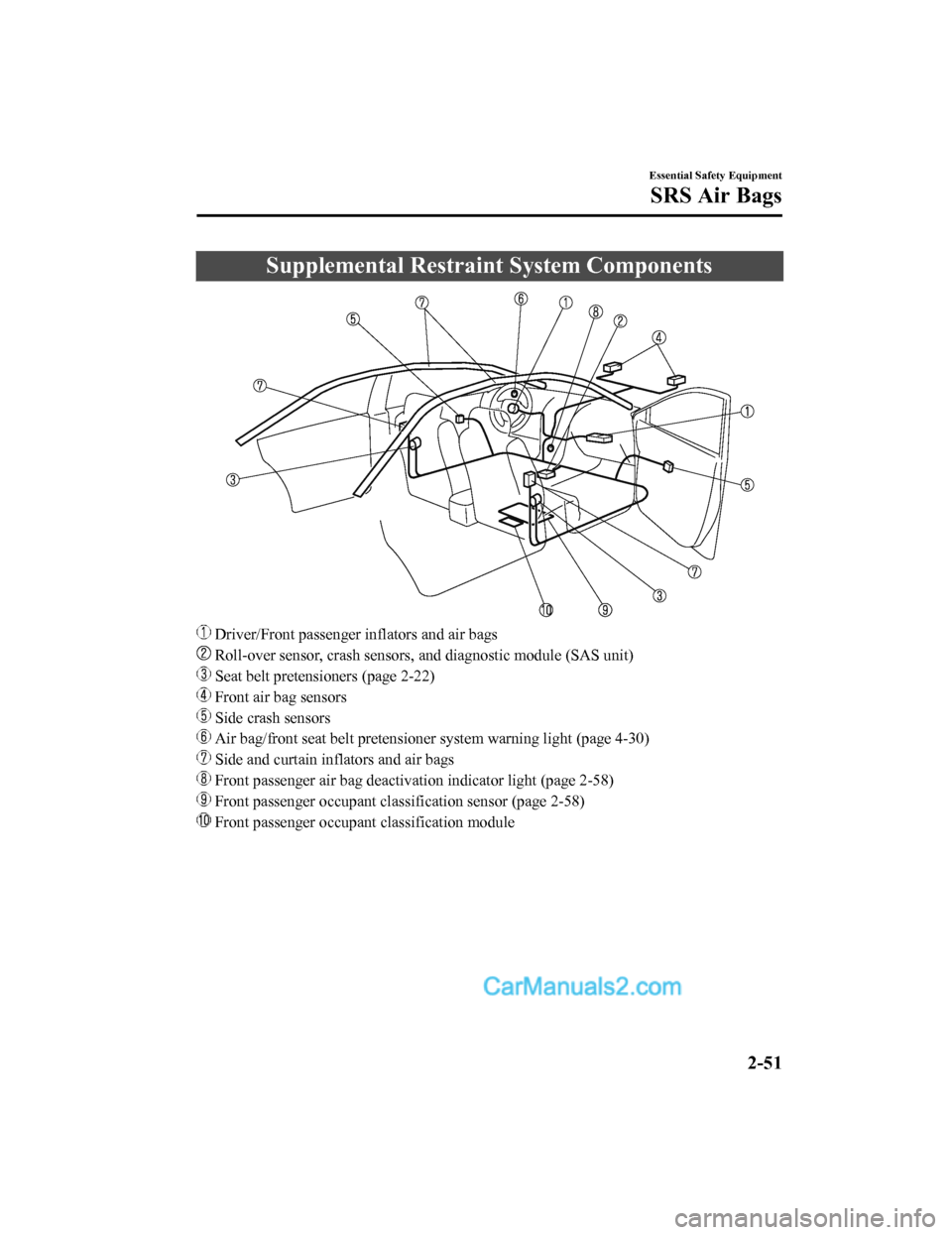
Supplemental Restraint System Components
Driver/Front passenger inflators and air bags
Roll-over sensor, crash sensors, and diagnostic module (SAS unit)
Seat belt pretensioners (page 2-22)
Front air bag sensors
Side crash sensors
Air bag/front seat belt pretensioner system warning light (page 4-30)
Side and curtain inflators and air bags
Front passenger air bag deactivation indicator light (page 2-58)
Front passenger occupant classification sensor (page 2-58)
Front passenger occupant classification module
Essential Safety Equipment
SRS Air Bags
2-51
CX-5_8GN5-EA-17J_Edition1 2017-8-18 12:58:27
Page 66 of 628
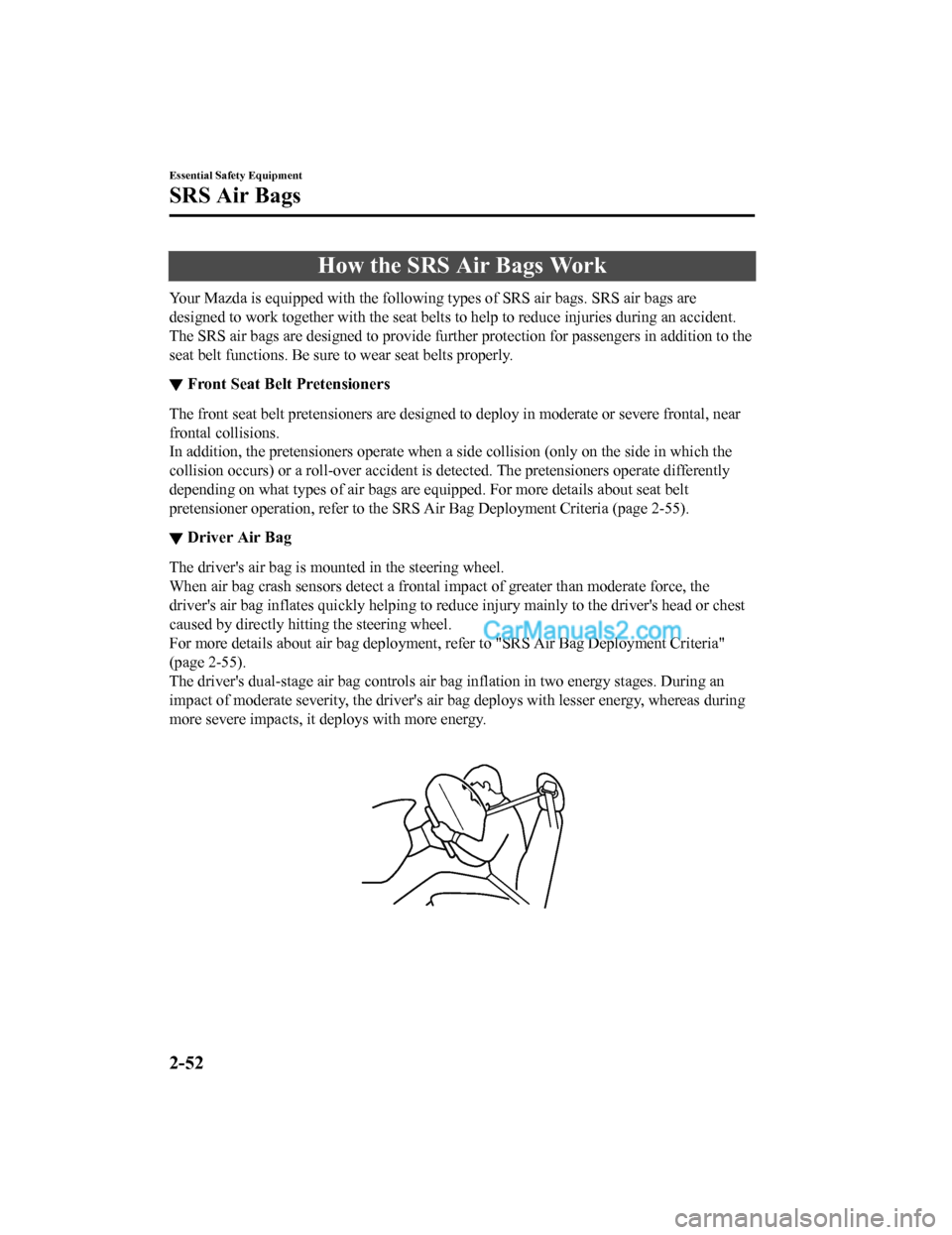
How the SRS Air Bags Work
Your Mazda is equipped with the following types of SRS air bags. SRS air bags are
designed to work together with the seat belts to help to reduce injuries during an accident.
The SRS air bags are designed to provide further protection for passengers in addition to the
seat belt functions. Be sure to wear seat belts properly.
▼ Front Seat Bel
t Pretensioners
The front seat belt pretensioners are designed to deploy in mod erate or severe frontal, near
frontal collisions.
In addition, the pretensioners o perate when a side collision (only on the side in which the
collision occurs) or a roll-over accident is detected. The pretensioners operate differently
depending on what types of air bags are equipped. For more deta ils about seat belt
pretensioner operation, refer to the SRS Air Bag Deployment Cri teria (page 2-55).
▼Driver Air Bag
The driver's air bag is mounted in the steering wheel.
When air bag crash sensors detect a frontal impact of greater than moderate force, the
driver's air bag inflates quickly helping to reduce injury main
ly to the driver's head or chest
caused by directly hitting the steering wheel.
For more details about air bag de ployment, refer to "SRS Air Bag Deployment Criteria"
(page 2-55).
The driver's dual-stage air bag controls air bag inflation in t wo energy stages. During an
impact of moderate severity, the driver's air bag deploys with lesser energy, whereas during
more severe impacts, it deploys with more energy.
Essential Safety Equipment
SRS Air Bags
2-52
CX-5_8GN5-EA-17J_Edition1 2017-8-18 12:58:27
Page 67 of 628

▼Front Passenger Air Bag
The front passenger air bag is mounted in the front passenger dashboard.
The inflation mechanism for the fr
ont passenger air bag is the same as the driver's air bag.
For more details about air bag deployment, refer to "SRS Air Ba g Deployment Criteria"
(page 2-55).
In addition, the front passenger air bag is designed to only de ploy when the front passenger
occupant classification sensor detects a passenger sitting on t he front passenger's seat. For
details, refer to the front passenger occupant classification s ystem (page 2-58).
▼Side Air Bags
The side air bags are mounted in the outboard sides of the fron
t seatbacks.
When the air bag crash sensors detect a s ide impact of greater than moderate force, the
system inflates the side air bag only on the side in which the vehicle was hit. The side air
bag inflates quickly to reduce i njury to the driver or front passenger's chest caused by
directly hitting interior parts such as a door or window.
For more details about air bag deployment, refer to "SRS Air Ba g Deployment Criteria"
(page 2-55).
In addition, the front passenger side bag is designed to only d eploy when the front passenger
occupant classification sensor detects a passenger sitting on t he front passenger's seat. For
details, refer to the front passenger occupant classification s ystem (page 2-58).
Essential Safety Equipment
SRS Air Bags
2-53
CX-5_8GN5-EA-17J_Edition1 2017-8-18 12:58:27
Page 68 of 628
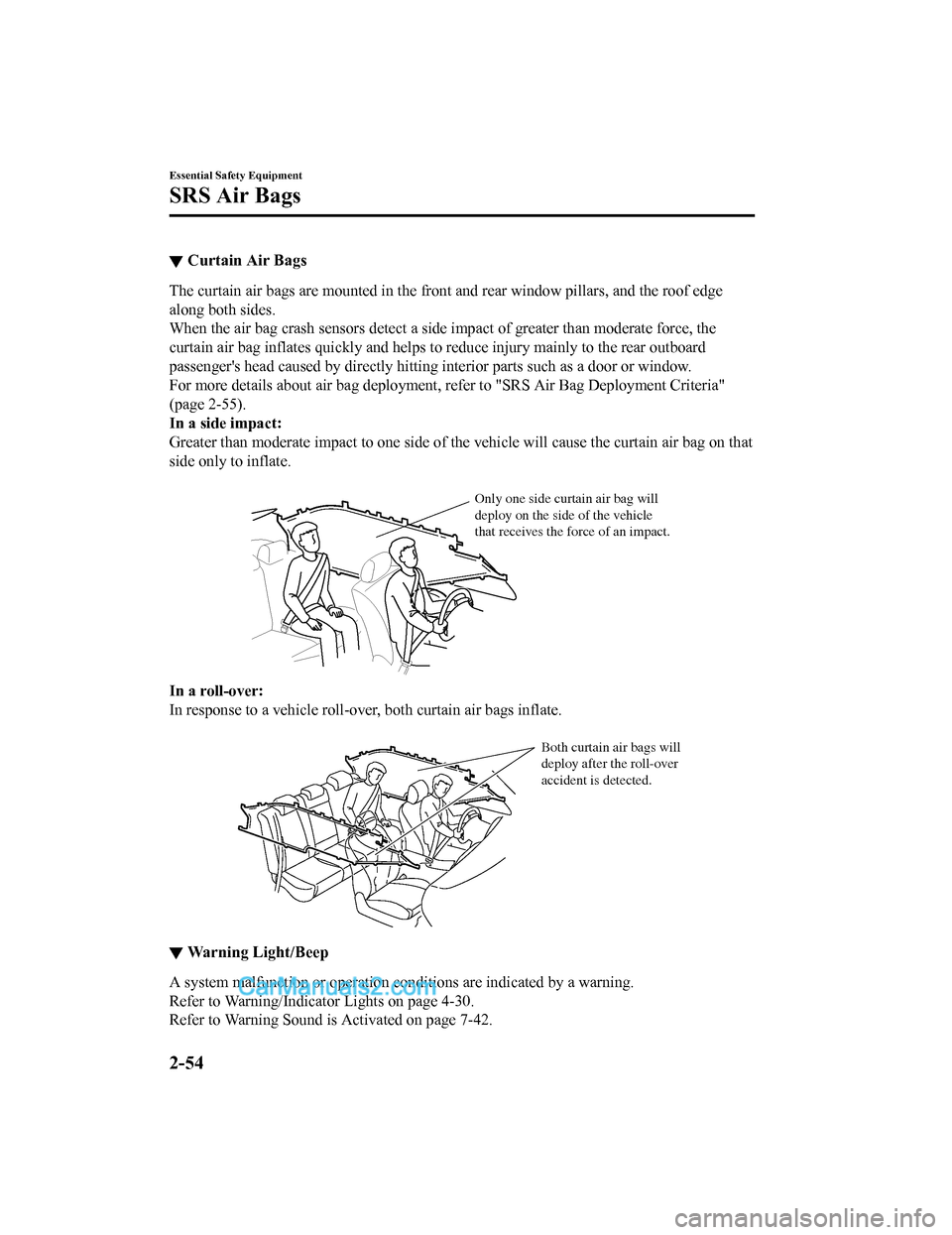
▼Curtain Air Bags
The curtain air bags are mounted in the front and rear window p
illars, and the roof edge
along both sides.
When the air bag crash sensors detect a side impact of greater than moderate force, the
curtain air bag inflates quickly and helps to reduce injury mai nly to the rear outboard
passenger's head caused by dir ectly hitting interior parts such as a door or window.
For more details about air bag de ployment, refer to "SRS Air Bag Deployment Criteria"
(page 2-55).
In a side impact:
Greater than moderate impact to o ne side of the vehicle will cause the curtain air bag on that
side only to inflate.
Only one side curtain air bag will
deploy on the side of the vehicle
that receives the force of an impact.
In a roll-over:
In response to a vehicle roll-ov er, both curtain air bags inflate.
Both curtain air bags will
deploy after the roll-over
accident is detected.
▼ Warning Light/Beep
A system malfunction or operation conditions are indicated by a
warning.
Refer to Warning/Indicator Lights on page 4-30.
Refer to Warning Sound is Activated on page 7-42.
Essential Safety Equipment
SRS Air Bags
2-54
CX-5_8GN5-EA-17J_Edition1 2017-8-18 12:58:27
Page 69 of 628

SRS Air Bag Deployment Criteria
This chart indicates the applicable SRS equipment that will deploy depending on the type of
collision.
(The illustrations are the representative cases of collisions.)
SRS equip- ment Types of collision
A severe frontal/near frontal colli- sion A severe side colli-
sion
*2A roll-over/nearroll-over*3A rear collision
Front seat
belt preten- sioner X*1 (both sides)
X*1 (impact side
only) X*1 (both sides)
No air bag and
front seat belt pre-
tensioner will be
activated in a rear
collision.
Driver air
bag X
Front pas- senger air bag X
*1
Side air bag
X*1 (impact side
only)
Curtain air bag X (impact side on-
ly) X (both sides)
X: The SRS air bag equipment is d
esigned to deploy in a collision.*1 The front passenger front and si de air bags and the seat belt pretensioner are designed to deploy when the front
passenger occupant classificati on sensor detects a passenger si tting on the front passenger's seat.
*2 In a side collision, the seat belt pretensioners and the side/ curtain air bags deploy (only on the side in which the
collision occurs).
*3 In a roll-over accident, the seat belt pretensioners and the c urtain air bags deploy.
NOTE
In a frontal offset collision, the equipped air bags and pretensioners may all deploy
depending on the direction, angle, and rate of impact.
Essential Safety Equipment
SRS Air Bags
2-55
CX-5_8GN5-EA-17J_Edition1 2017-8-18 12:58:27
Page 70 of 628

Limitations to SRS Air Bag
In severe collisions such as those described previously in "SRS Air Bag Deployment
Criteria", the applicable SRS air bag equipment will deploy. Ho wever, in some accidents,
the equipment may not deploy depending on the type of collision and its severity.
Limitations to front/near front collision detection:
The following illustrations are e xamples of front/near front collisions that may not be
detected as severe enough to deploy the SRS air bag equipment.
Impacts involving trees or poles Frontal offset impact to the vehicle
Rear-ending or running under a truck's tail gate
Essential Safety Equipment
SRS Air Bags
2-56
CX-5_8GN5-EA-17J_Edition1 2017-8-18 12:58:27